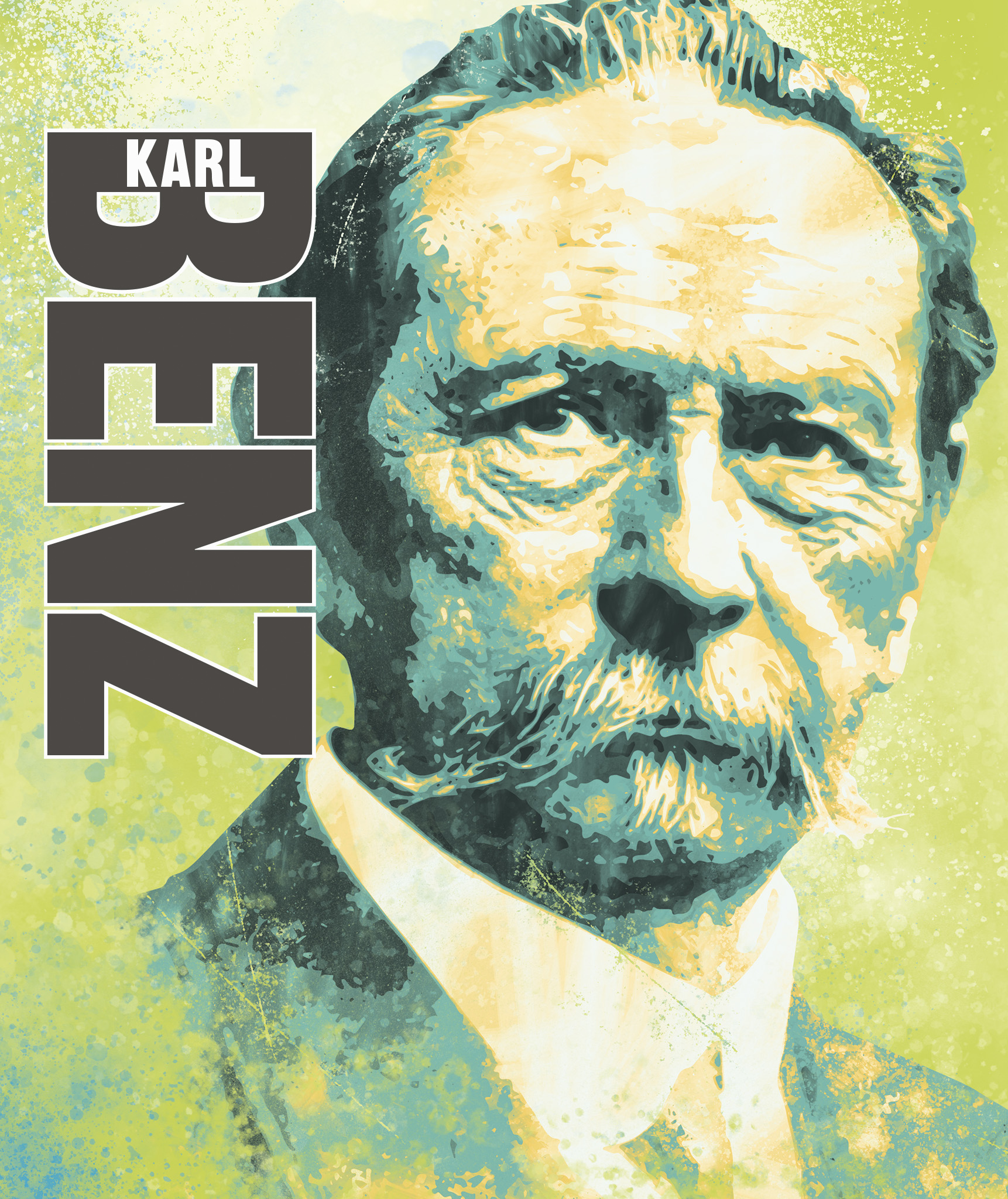
KARL BENZ
1844–1929
Engineer Karl Benz’s vision was to design a mode of transportation for the general public that required neither horses nor rails. In developing the “horseless carriage,” the first practical automobile powered by an internal combustion engine, he revolutionized the way in which people were able to travel.
Karl Friedrich Benz was born in Karlsruhe, Germany, and was just two years old when his father, a train driver, died. As a boy, Benz fixed watches and clocks to help his mother financially. At school, he excelled at his studies and went on to take a degree in mechanical engineering at Karlsruhe University. While there, he studied the steam train and began to formulate his ideas about a self-propelled engine that would run on something other than steam and could travel freely without rails. After graduating from college at the age of 19, Benz worked in various companies as a mechanical engineer, but he spent every spare moment on his engine design.
Building his vision
In 1871, Benz set up a workshop in Mannheim with a partner, August Ritter, but the business ran into difficulties, and Benz’s tools were confiscated by bailiffs. Benz’s future wife, Bertha Ringer, paid off his debts, and when they married in 1872, Bertha used her dowry to invest in her new husband’s workshop.
Benz set to work on his engine design, devising and patenting an electric coil ignition system, a speed regulation system, spark plugs, a radiator, a carburetor, a clutch, and a gear-changing mechanism in the process. Finally, in 1883, he found backers for his “horseless carriage”: bicycle manufacturers Max Rose and Friedrich Esslinger. Together, the three men set up a new company, Benz & Co., and Benz built the first automobile, which he dubbed the “Motorwagen.” In 1886, he successfully patented his design as the first “gas-fueled automobile.”

Karl Benz’s wife, Bertha, had complete faith in her husband’s vision for a “horseless carriage.” It was only with Bertha’s help that Benz was able to accomplish his dream.
Marketing the Motorwagen
Bertha Benz played a major role in bringing her husband’s invention to the public’s attention, and she also helped enhance its design. In a bid to generate publicity for the Motorwagen while proving its reliability, she and her two teenage sons went for a 75-mile (120 km) “joyride” from Mannheim to Pforzheim in the Motorwagen in 1888. Leaving in the morning, they completed the trip by nightfall. It was the ultimate road test and publicity stunt.
Bertha had to make regular stops to refuel the gas tank at apothecary shops that sold the gas solvent ligroin. She also visited a cobbler’s to improve Benz’s brake design, nailing leather strips to the wooden brake blocks to create the world’s first brake pads. When she reached Pforzheim, Bertha sent a telegram to her husband to tell him about the trip.
The outing was a marketing success. Many people saw the Motorwagen drive past and news about it spread quickly. Orders for the automobile poured in to Benz & Co., and Benz expanded his factory facilities to cope. An improved Motorwagen design was launched at the 1889 Paris World’s Fair to great acclaim, and over the next decade the number of Benz & Co. employees grew from 50 to 430.
By the end of the century, Benz & Co. was the leading producer of automobiles in Europe, and Benz had patented further engine designs. He retired from the company in 1903 but remained on the board of directors. In 1926, Benz & Co. merged with its competitor, Daimler, to form the Daimler-Benz corporation. Karl Benz died in 1929, followed by Bertha in 1944. However, his many innovations continued to influence the automotive industry.


Benz’s Motorwagen turned heads in the cities of Europe when it took to the streets. Sales of the automobile soared following its appearance at the Paris World’s Fair in 1889.
“Only one person remained with me in the small ship of life when it seemed destined to sink. That was my wife.”
Karl Benz, 1925
LOUIS-JOSEPH CHEVROLET

Born in Switzerland, Louis-Joseph Chevrolet was a racing-car driver, automobile designer, and cofounder of the Chevrolet Motor Car Company.
Chevrolet (1878–1941) moved to the US in 1901 and became a racing-car driver for Buick, breaking records on every major US racetrack. He then designed his own six-cylinder engine and cofounded the Chevrolet Motor Car Company with William C. Durant, owner of Buick. However, Chevrolet had little faith in his designs and sold his share in the company to Durant in 1915. The company was then incorporated into Durant’s General Motors. Chevrolet returned to racing and building motor parts for his new company, the Frontenac Motor Corporation.
MILESTONES
CHANGES PATH
Focuses on locksmithing as a student, before switching to mechanical engineering in 1860.
BUILDS BRIDGES
Works at a bridge-building company in 1868, before a brief stint in Vienna at an iron construction company.
CREATES FIRST CAR
Takes the first orders for his Benz Motorwagen in 1888, making it the first automobile for the public.
BREAKS RECORD
Introduces a racing car, the Blitzen Benz, in 1909. Sets a land-speed record of 140 mph (226.1 km/hr).
